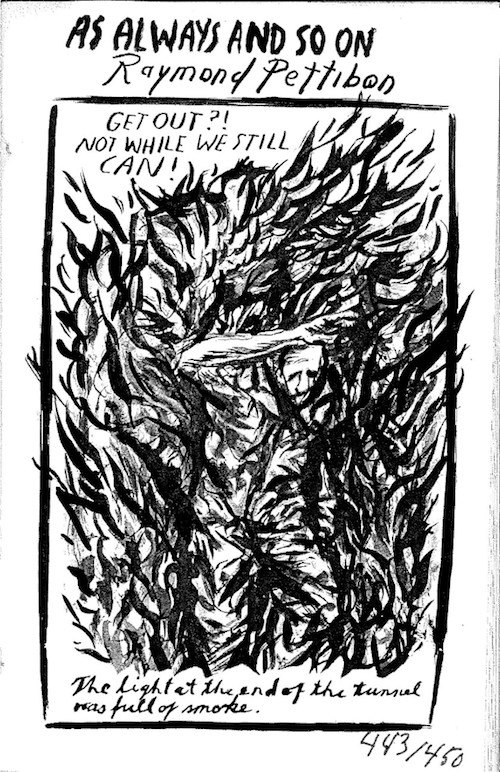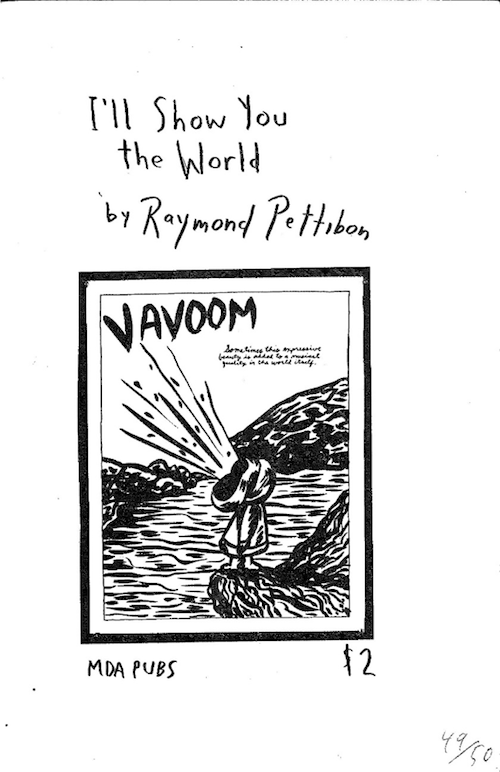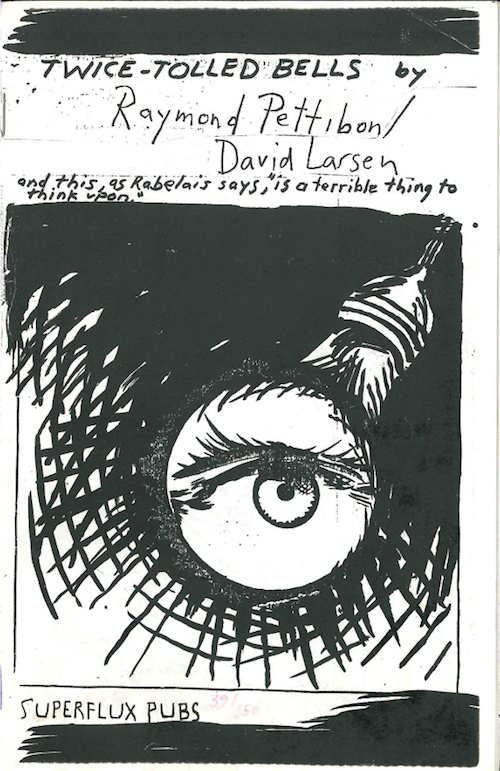A Petty Bone to Unpick

Like many people, I discovered Raymond Pettibon’s artwork through his ink drawings that were used on a few SST Records album covers, most notably Black Flag’s Slip It In, which my neighbor had somehow procured in 1984 (interest in punk rock was practically non-existent in the small Central California town where I grew up). I know Pettibon despises the punk rock connection his work always conjures up. In an interview with the website Culture Creature, he unequivocally states, "I never considered my work part of the punk scene or music scene of any sort. It held me back. It's still something that is kind of hard to conceive… It's buried in time as being such a part of my background the way that people seem to think so. It really wasn't in the first place." According to other interviews with him that I’ve read, the people involved in the L.A. punk scene were anti-intellectual and had little to no interest in books, especially the zines he was producing. When asked about the commodification of punk in The Guardian's December 14th, 2013 edition, he tangentially says, "It was more about what you can't do than what you can do. There were restrictions. Any intellectual curiosity was discouraged." Possibly? Or perhaps he just ran with the wrong folks? I immediately think of Exene Cervenka, Mike Watt, D. Boon, and Chris D as literate folks. Anyhow, I ain’t one to argue. Those stapled and Xerox’d publications were Pettibon’s calling cards, albeit ones that at the time were supposedly ignored by punks and the art world alike, although copies now command upwards of $200 (even more for copies of his first booklet, Captive Chains). Someone was paying attention to him in the 1980s!
I’m not going to rehash the topics and cultural obsessions Pettibon has on display in the zines, as the art and mainstream press for his recent survey at the New Museum in New York have already covered them. I will say that he is a master satirist. What appears in some of his publications are scaled-down versions of what hangs on gallery walls, more or less. As far as the text(s) that are inserted into his work, most observers seem beguiled by them, although they are a significant part of his drawings and should really appeal to poets or other appreciators of the language arts. I think the A Pen of All Work catalog provides a wonderful peek into the sources of the texts: little scraps torn from books that Pettibon is either reading, scanning, or casually dipping into in order to find that one odd, insightful, or a random bit he then decides to work into a drawing, creating this often disjunctive experience between image and word. He favors Henry James, John Ruskin, and Emily Dickinson. Personally, I’m reminded of James Joyce’s interior monologues in Ulysses or some of Celine’s elliptically hiccupping lines in Death on the Installment Plan. There’s also an urgency to some of the writings and a certain type of violence, both direct and indirect. They also come across as cribbed from noir crime films or the abject autobiographical musings of followers of failed cults. A whole slew of politically motivated drawings include texts that are barbed, sardonic, and darkly direct in their criticisms of failed U.S. foreign policies. But the texts aren’t always captions describing the visual aspects as much as they are set at an obtuse angle from the drawings. Sometimes the text acts in accordance with the drawing; most other times the imagination must stretch to accommodate any semblance of meaning between the two. And really, that’s where the fun begins for me. The surface incongruence draws me in: my brain starts finding associative elements, and more times than not, fails in doing so. One of the reasons I keep returning to his work is that I am endlessly perplexed and fascinated by the less linear of his writings. In a 2003 video interview with Art21.org, Pettibon states, “I spend a lot more time writing than I do drawing. I really want to make that distinction and feel the need to separate the two.” I highly recommend watching the segment as it provides some good insights into Pettibon’s writing/drawing practice. His parents and his, at-the-time, landlord’s comments are especially interesting, as they give more objective views of his working methods, at least during that period.
While looking through the Pettibon produced zines in SFMOMA's Special Collections where I work as a library assistant, I was surprised to see that one of them, Twice Tolled Bells, was a collaboration with the poet and translator David Larsen (his translation of Ibn Khalawayh’s Names of the Lion will appear this year from Wave Books). I met David in the late-90s, I believe. I don’t recall the circumstances, and we haven’t been in touch in the intervening years from what I recall. Thankfully, I was able to procure David’s email address and he was amenable to answering a couple of questions about his collaboration with Pettibon. So without further ado.
BL: I think that Raymond Pettibon’s work (especially from the angle of his texts) would be of interest to poets. The borrowings, the collage aspect, taking “random” lines out of context. That strange feeling when the mind tries to make connections between word and image, and that connection may not even be there.
DL: Agreed—the work ought to be of interest to poets, and from conversation with poets I think it is, whether or not they’d think to name him as an influence. On me, his impact was certainly profound. Dodie Bellamy’s written about him, though more as a peer and collaborator than an influence.
BL: How did the collaboration with Pettibon come about?
DL: I met Raymond in 1994. Our normal way of working was for him to paint an image onto a linoleum block, and for me to carve the block and print it. I never added language to the prints, and I was happy in the assistant’s role. It was Raymond who suggested we collaborate on a zine. Looking back, I surmise that the impulse came from his affection for the form—zine form, I mean, which is a form most people don’t stick with. Self-published zines had at one time (early- to mid-80s) been the primary venue for Raymond’s work, but by 1996 I don’t think he was doing so many. Still, he’s a past master of the form, and seeing me excited about zines still, it must have seemed natural for us to do one together.
BL: Where did you collaborate on this? Were you in the same room?
DL: Yes—his room on the upper floor of his parents’ house in Hermosa Beach. I think we did it in a single day.
BL: Did you plan to do a zine together? Did you have any input as to what images of Pettibon’s were included?
DL: We didn’t collaborate on individual pages, only in assembling the whole. I did not act as a curator or editor of Raymond’s work—that was all him, as were the title and front cover.
BL: Did you choose what medium to use for your contribution, or was it obvious at the time (india ink would’ve been plentiful in his studio, I’m sure)?
DL: My choice of medium was constrained. Collage was my forte, but for that you need your own materials and mine weren’t with me. Raymond, meanwhile, had his whole archive to draw from, and all his pages were collaged together from it. So I picked up brush and ink—a medium I hadn’t worked in much, and haven’t gone back to since. Talk about bringing a knife to a gun fight!
My usual way of doing zines was to spend whole nights on a single page. To sit down and turn out sixteen pages in a day, at the feet of the artist you admire most in the world,—well it was a wonderful thing and I’m glad it happened.
***
Twice-Tolled Bells was reprinted twice: in Shark #3 (Winter 2000), and in Raymond Pettibon: The Books 1978-1998, ed. Roberto Ohrt (Distributed Art Publishers, 2000). All scans courtesy of the SFMOMA Library and Archives.
Poet, painter, and musician Brian Lucas published his most recent book, Eclipse Babel (Ensemble Editions), in 2015. His paintings were featured in the recent exhibitions Dark Star: Abstraction and Cosmos (Planthouse in New York City) and Divine Invasions (Krowswork in Oakland). He plays in the band Dire Wolves, whose most recent albums are Excursions to Cloudland (Beyond Beyond is...



